Well, I guess I lied. I said I’d be shrugging off the shackles of 8-bit oppression with this entry, but here we are looking at a game on an 8-bit system with 2-bit color. I was going to dig into The Legend of Zelda: A Link to the Past in honor of A Link Between Worlds’ launch today, but that didn’t pan out. Unfortunately, my intended venture hit a bit of a delay as my copy appears to have vanished. Anyone looking to offload a copy of A Link to the Past on the cheap…?
But I guess that’s OK. I was going to get to Metroid II sooner or later… and the sooner I get to that, the sooner I can move on to Super Metroid, which will be tremendously entertaining.
I’ll admit, it feels a little weird to be exploring Metroid II. I wrote a fairly scathing (and not entirely fair) retrospective on the game a decade ago, which now comprises like half the content on the game’s Wikipedia entry. (Feel free to edit that out; I’m not allowed.) I went back and revisited the game last year to give it a second chance for GameSpite Journal 11, and I suppose I really ought to post that article and the rest of the back half of that book one of these days. If only I could remember where I put the original files for that issue.
Well, anyway, this will be a fair shakedown cruise for the game. I have complaints about it, absolutely, but I’m not afraid to give it praise where praise is due.
Metroid II: Return of Samus
As a sequel to Metroid, Return of Samus doesn’t stray too far from the original game’s fundamental premise. You are a woman alone in an underground labyrinth full of space monsters, with no one and nothing to rely on save your extraordinary armored suit and its remarkable capacity for absorbing power-ups people left littered about the planet interior. In this case, however, you’re not out to thwart the metroid-breeding plans of space pirates but rather to exterminate the metroids themselves. In their natural environment, metroids turn out to be rather more diverse than the events of the first game would let on — but we’ll get to that.
From a fundamental mechanical perspective, Metroid II differs from its predecessor in terms of the hardware that hosts it. The Game Boy lacks some of the limitations that affected older NES games such as Metroid, so now the game world can scroll freely in all directions — no more alternating horizontal and vertical chambers. This also means fewer insanely lengthy shafts to ascend. However, the ability to scroll freely is also something of a necessity, as the Game Boy’s pixel dimensions are considerably smaller than those of the NES — 160×144 versus 256×224. A single screen of the NES game represents more than a screen and a half for the Game Boy.
To make matters worse, Samus is actually slightly taller on Game Boy than on NES — 36 pixels versus 30 — in order to let her sprite “read” more easily in a world without color. The added height allowed the designers to make her slightly more detailed (including the introduction of a trademark feature of her power suit, the addition of large shoulders to denote the Varia power-up), but it also means she occupies that much more of the screen.
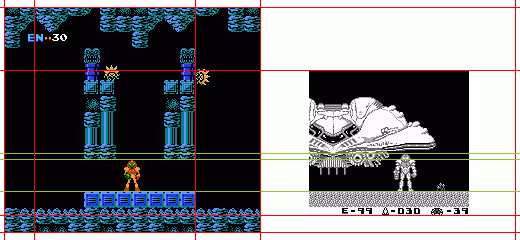
This is not an insignificant consideration, as you can see here with this side-by-side comparison of Samus’ height versus the screen dimensions in each game. She’s gone from occupying about 1/8 of the screen to 1/3 of the active screen (the permanent status bar at the bottom being functionally useless in terms of revealing the game world). By increasing the protagonist’s size while dropping a massive amount of environmental information, Metroid II by nature plays differently than the original game. The action becomes slower to prevent you from rushing ahead too quickly and falling athwart hazards, and to keep enemies from taking cheap shots from off-screen. It reduces Samus’ range of attack. It complicates jumping once you’ve boosted Samus’ powers. Combined with the monochromatic color scheme, it makes differentiating environments more difficult, making for a more linear game to minimize confusion. Nintendo R&D1 (and specifically its two very talented directors who went on to create the Wario Land and New Super Mario Bros. series) aspired to bring an NES-quality experience to Game Boy, and compromises were in order to make it possible. But dammit, they tried.
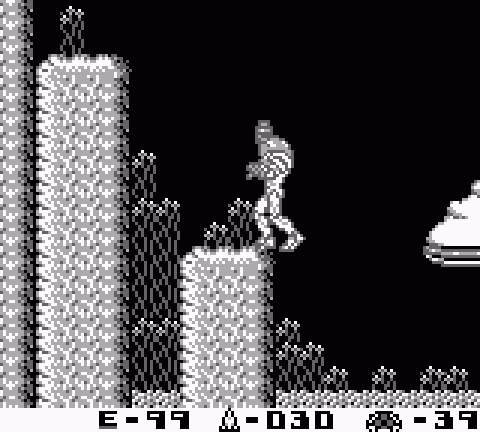
One thing I appreciate about Metroid II: It pays more than narrative lip service to the fact that it’s a sequel. Samus doesn’t start in the same diminished state as at the beginning of the first Metroid. She’s hardly powered up to the maximum here, but she does at least enter the adventure with missiles (30 max to start with) and the Long Beam. Very few sequels resist the urge to hit reset on their protagonists — including subsequent Metroid games, it should be said — so it’s actually pretty unusual to see the heroine start off with a handful of power-ups in hand. This is a conscious choice by the designers to empower the player at the expense of reducing some of the early challenge of the game; no doubt the fact that this removes missile-access doors from the mix entirely (thus taking a barrier to progress out of the adventure) is why no other Metroid adventure gives Samus missiles from the outset. Sometimes narrative consistency proves to be less important than mechanical variety… though in an ideal game, the two exist in harmony.
However, Metroid II is much less a game about exploration and discovery than any other entry in the series, so the absence of missile doors as a barrier to progression makes no real difference. Again, this is a far more linear and directed quest than its predecessor, and that fact becomes clear at the very outset. Where the first Metroid required you to backtrack left from the starting point before you could progress to the more traditional right, what you’ll find to the left of the starting point here is… a wall. It’s right-scrolling only for now, sister.
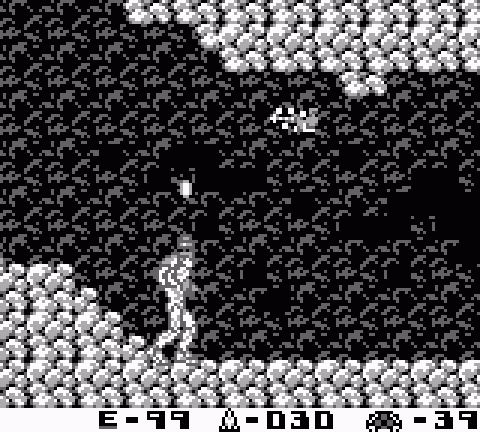
The early creatures you’ll face somewhat resemble those of Zebes. These guys look like corn on the cob, but they drift left and right somewhat like Rippers from the first game. However, you don’t need a missile to blow them up. There are also frog-like monsters that jump at you. Everything here is slow and poses little threat… and in any case, this game starts Samus with 99 health from the outset instead of forcing her to build up from 30 via enemy drops. A small but welcome touch of grace. Metroid II also presents you with occasional refill stations to max out your health and missiles automatically, greatly reducing the rigorous grind of the original game.
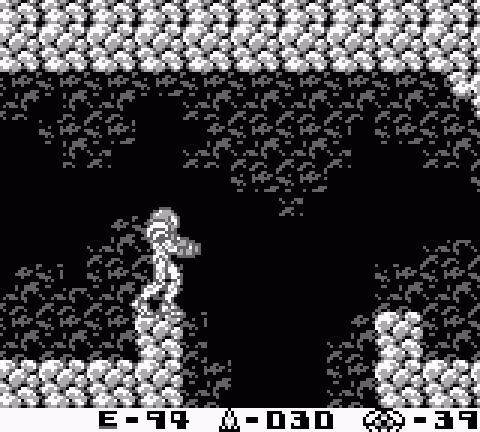
You can only progress right at the beginning of the game. Right, and then down. Where the original Metroid presented you with that maddeningly endless shaft to climb right at the start, here you instead have a much easier trip downward. There’s no other path forward, which means you can only drop into this hole. If you’ve never played Metroid, this is where the game confronts your misgivings about pits equalling instant death. There’s no such thing in this universe, and by forcing your hand a couple of screens in, Metroid II nudges you past your platform gamer’s instinctive terror of gaping openings with no obvious bottom in sight. “Jump in,” it says. And when you pause in fear, it waits patiently while you cast about fruitlessly for an alternative and finally give in and jump already.
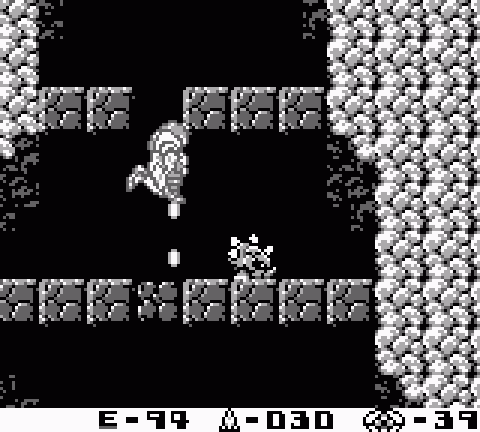
You’ll survive the fall, which isn’t deep at all, only to be confronted with barriers. These blocks are designed with the universal cartoon shorthand for “fragile rock,” and it should be clear both from the cracked texture and the blocks’ lack of the surrounding walls’ organic smoothness that you can blast through them. This part is clearly intended as a revelation specifically for Metroid veterans; where someone groomed on the likes of Contra will assume it ain’t no thing to shoot downward, Samus could only fire forward, backward, and up in her debut performance. To destroy things at ground level, she had to duck into a ball and drop a bomb. But you don’t have the ability to lay bombs yet. So what to do?
If you duck here to roll into a ball, you’ll make the surprising discovery that Samus now ducks before rolling. (You have to press down twice to enter the ball state now, hence her evidently baffling inability to crawl.) This means she can shoot things at ground level — something that would have come in quite handy in the original game. But ducking still doesn’t let you shoot downward. In order to do that, you need to jump and aim down while in the air. Easy enough, but it’s also the first of Samus’ new abilities, and the game does well to make its mastery a requisite to advance from beyond the introductory area.
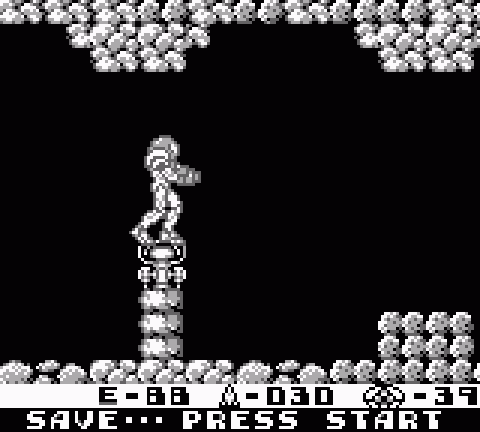
If you continue pressing forward (that is, rightward and downward), you’ll eventually come to this little pylon, which is one of Metroid II‘s other new features: A save point. By pressing Start here, you’ll save your progress. No more messy passwords to deal with. This is a simple function of technology — Metroid slightly predated the spread of battery saves from the premium Legend of Zelda into games without fancy gold carts — but a very welcome one.
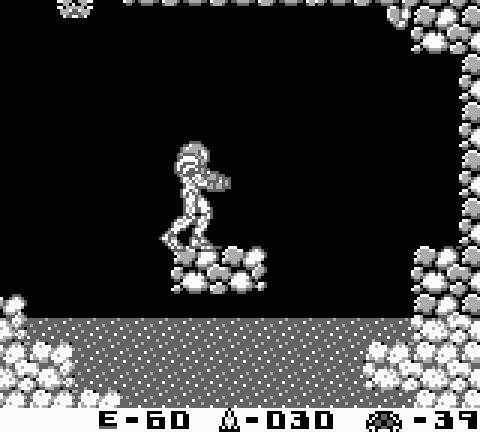
Eventually, though, the path to the right dead-ends with a lake of acidic liquid that will kill Samus pretty quickly if you attempt to take her for a swim. This is as far as you can go the right, and at last you’re forced to reprise the original Metroid and see where heading left will take you.
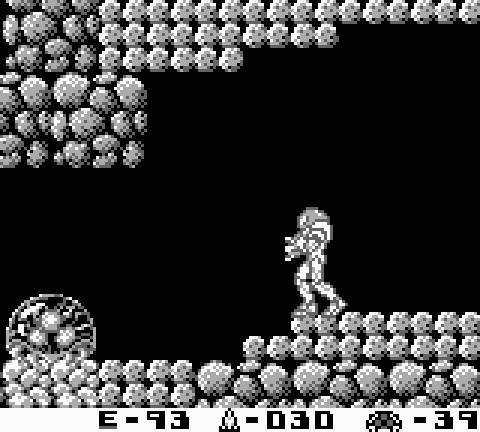
Oh.
Haha! Nice ending to this article.
I bought my original GameBoy for this game, (but I played Super Metroid first, so i was slightly out of order) I remember being lost for days in corridors as I never adequately mapped my way through the planet. I somehow managed to get to the final boss, though I never could quite beat her. I’m looking forward to reading this Anatomy, to relive my younger days.
I’ve eagerly anticipated this article from the moment this series started, I’m not really sure why. Maybe because so much attention is focused on the first Metroid for being so revolutionary and for Super Metroid for being just plain divine, so this odd middle child gets short shrift. There are plenty of articles appreciating/hating on it, but I’m really excited to see you really break it down and analyze the design choices.
I very much enjoyed this article and the way you broke down the ways in which the Game Boy experience forced compromises and changes upon the designers.
Can’t wait to read more!
A return to one of my favourite videogame series. I really wish that they would have remade this game on the GBA. I really enjoyed Zero Mission and was hoping to have an updated version of Metroid II.
I don’t know why, but that first picture comparing the dimensions of Metroid to Metroid II is one of the best things I’ve seen in a long time.
I’ve been meaning to replay Metroid II for a long time and I think I will do just that once I work my way through my handheld backlog. I wonder how it holds up after all those years.
And there’s the exact moment I learned that a video game could terrify you.
Looking forward to the reading all of this.
I understand that the large sprite was somewhat due to the platform, but it seems a number of sequels have gone the route of larger sprites in sequels to detriment of the game. Rastan and Nastar spring to mind where the first was a fun, difficult adventure fling and the sequel was a near unplayable mess where your sprite took up 1/3 of the screen.
I’m actually really looking forward to this series. Metroid 2 was actually the first Metroid game I played.
It freaked me the fuck out.
I honestly think Jeremy undersells the atmosphere a bit. While I don’t know how much is intentional. But between Samus’ low vision range, the black and white palette, and the low, menacing music, it really does feel like you’re advancing into an abandoned world inhabited by a hostile alien species.
Hope this guy gets to finish and release his remake of Metroid 2. It looks very nice.
http://metroid2remake.blogspot.com/
You should try out both the demo and little self contend tech demo, Mr. Parish. I think you will like them.
But odds are Nintendo will C&D it. Wish more companies were like valve, who seems to support people making stuff based on their games.
http://www.destructoid.com/black-mesa-to-be-sold-on-steam-alongside-free-version-266008.phtml
@Yasri I’ve been watching Project AM2R for ages (and can’t play the demo, I don’t have Windows). I worry it’ll never be done because of all the feature creep. It started as a remake but has become something much more as he keeps adding new features and content.
I just want Nintendo to remake the bloody thing themselves already. I might have preferred that to Zero Mission, since I never quite got into this one the same way.
Wow, I did not expect to agree almost completely on sometihing you write about Metroid 2, Jeremy Reading this actually made me feel a little like that young boy I once was, being sucked into my very first Metroid and discovering how things worked on that strange and wonderous planet called SR-388.
Reading this actually made me feel a little like that young boy I once was, being sucked into my very first Metroid and discovering how things worked on that strange and wonderous planet called SR-388.
I still play it from time to time. And it is still amazing how dense the atmosphere can be on the primitive Gameboy hardware. Samus’ increased sprite size may limit the range of view, but on the other hand it adds to the immersion (further increased by that glorious cover art back then). Soundwise the designers also made quite brave and smart choices, especially the way “real” music is only used sparsely to accentuate certain situations.
Really looking forward to AM2R, too!
The cramped nature of Metroid 2 raises two questions in my mind:
What if Samus in this game had been tiny instead, like Mario in Super Mario Land?
How did Link’s Awakening not feel cramped compared to Legend of Zelda despite having the same sized Link sprite?
@J.Parish: I’m assuming your preferred method of replaying LttP would be via Game Boy Advance since it’s the only portable one, but if you’ve got access to a Wii or Wii U in your off time, Club Nintendo has The Legend of Zelda: A Link to the Past as a 150 Coin prize right now.
Dunno if you’re eligible for the service since you’re in the biz and all, but that’s like, three to four Wii U or 3DS game registrations plus surveys. I also think registering a system will get you about 100 coins or so.
@Egarwaen: Yeah, one thing that stands out to me is that Metroid II has great atmosphere. The monochrome palette, the darkness, the ambient sounds, even the jerky enemy framerates. It’s a very otherworldly experience.
@J. Parish If your on a mac and adventurous you can give wine a shot. Never used it as I do not own a mac but on Linux it works good.
http://wiki.winehq.org/ThirdPartyApplications
http://winebottler.kronenberg.org/downloads
AM2R seems to still be chugging along, he posted a update just a few days ago. He said his going to try prioritizing to get the first chunk of the game done so he can release it. Who knows if that will happen, but it is a thing.
“acidic liquid”? I always thought that was lava or something 😛
I actually like Metroid 2 a lot more than Metroid 1. It’s a lot scarier too.
There’s something about those music-less corridors that make me feel like I’m in this really isolated place with absolutely no other human or anyone to help me.
When I think of this game I typically don’t think of it as monochrome, since most of my time spent playing this game was on the GBA. The GBA (and probably the GBC) made the backgrounds blue and the sprites red/orange. The color scheme fits surprisingly well, so much that I think it might be intentional (how they could have done it, though, remains a mystery).
@RT-55J Nintendo kind of cheated with the Super Game Boy/Game Boy Color/GBA hardware. They added the ability to colorize standard GB carts to those machines, but for a handful of first-party titles they added more advanced palettes that broke the rules, so to speak, by colorizing different elements individually and allowing those games to have more than four colors. Metroid II in particular was meant as a showcase for the SGB, so it got to be extra-fancy.
My earliest memory of this game is seeing it in the booklet of free stuff you could get if you drank enough kool-aid. Alas, I never did drink enough; but at least I walked away without diabetes.
I did play the game by other means later. In fact, I’m pretty sure I finished Metroid II long before the original. It’s quite a bit easier, after all, especially when you can play it in the car.
@Vega: Metroid 2 with SML proportions would certainly be not as intimate, less about “being Samus” and the feeling of underlying claustrophobia and instead more about “being there”. Would be an interesting a trade-off, but I prefer the route they took. Also: anything smaller, than the sprites for Operation C for example, tend to look rather comical on the Gameboy (see: Sunsofts first Batman), which would not fit the tone Metroid 2 aims for.
Link’s Awakeing on the other hand has the benefit of generally slower movement (especially vertically) and no actual scrolling.
I think the compromise they found for Metroid 2 (and for other R&D games like SML2 aswell) works well enough: The sprites are not centered, so the player usualy has almost 2/3 of the screen to see what lies ahead.
I never played this on the GB but picked it up last year as my Club Nintendo reward and played it over Christmas. I really enjoyed the game and didn’t understand the ire I saw towards it on the internet. I only got stuck once for a brief period, and beat the game in less than 10 hours. I thought is was compact and thoughtfully designed.
@J.Parish: Besides the special palettes, a few of the built-in color palette options altered sprite colors as well. The one I do remember is the red palette turning sprites green.
Also, using palettes with different palettes for sprites can result in some odd stuff, since of course some things are made out of both sprites and background parts. Case in point, the Metroid Queen having a red and yellow head and neck but a blue body.
Love this treatment! I knew people didn’t abandon “Anatomy” it was just Kid Icarus